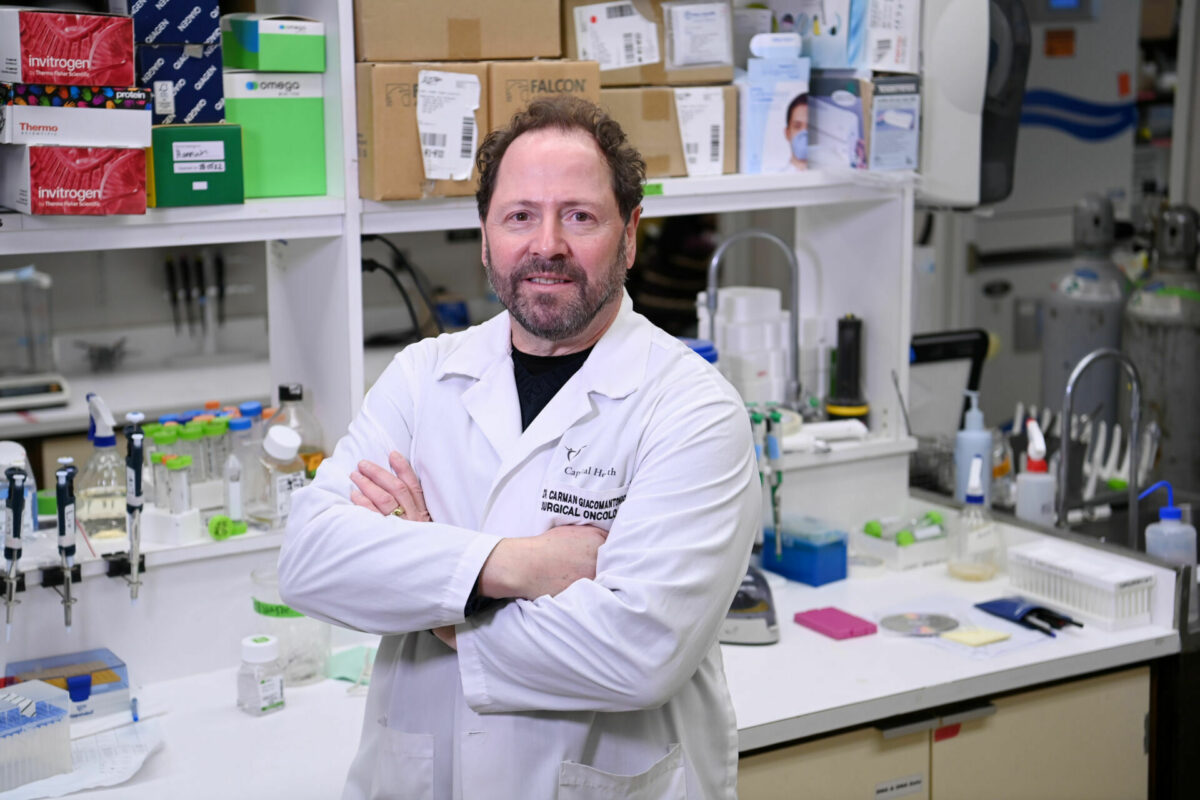Heating Up the Fight Against Cancer: Dal Researcher Develops Targeted Immune-Boosting Therapy
May 28, 2025
By Laura Eggertson
An innovative new method of generating fever heat to kill cancer cells and trigger an immune response promises to become an effective and accessible way to destroy hard-to-treat tumours, says a Dalhousie researcher involved in pioneering the process.
Dr. Carman Giacomantonio, who holds the Gibran & Jamile Ramia Endowed Chair in Surgical Oncology Research, published a proof-of-concept study January 13 in Frontiers in Immunology. The peer-reviewed paper describes the process he developed in conjunction with Sona Nanotech Inc., a Halifax-based nanotechnology company for which he is now the Chief Medical Officer.
In the paper, Dr. Giacomantonio describes the way tumours from breast cancer and melanoma shrank after he and his team injected them directly with tiny gold nanoparticles and then used infrared light to heat the gold. The process, called Targeted Hyperthermia Therapy, generates fever-level heat of 42-48 degrees Celsius.
“Unlike ordinary cells, when you stress cancer cells at 45 degrees for a while, it triggers a cancer death cycle,” Dr. Giacomantonio says.
Stressing the tumours with hyperthermia then creates an immune response, triggering the body’s innate defence mechanism within 48 hours.
“It’s beautiful,” Dr. Giacomantonio says. “You can see the tumours melt. It is as rare as Halley’s comet that you see something work so effectively to wipe out tumours. And it’s just natural.”
When the research team followed up the hyperthermic therapy with an immunotherapy medication, such as interleukin-2, the cancerous tumours did not appear to regrow.
“We learned that if you cajole the immune system at the same time with immunotherapy, you can finish the attack and kill the tumour effectively,” he says.
The team carried out their studies using tumour cultures and genetically engineered animal (mouse) models. Although those models are not directly interchangeable to human, “there’s enough overlay that the principles should apply,” Dr. Giacomantonio says.
Although the cancers involved were a type of breast cancer that does not respond well to chemotherapy or radiotherapy, and melanoma, Dr. Giacomantonio and his team are also working with two kinds of colorectal cancer tumors and hope to soon move on to a pancreatic cancer model.
He believes this type of therapy has widespread potential to benefit many types of cancerous tumours, because of its ability to stimulate an immune response and enhance the benefits of immunotherapy.
“The name of the tumour is irrelevant, if we’re right,” Dr. Giacomantonio says.
Hyperthermia is an emerging way of treating cancer, which Dr. Giacomantonio has been using in his own practice. However, using hyperthermia to kill cancerous cells has been a fairly high-risk procedure performed in a hospital that requires isolating and heating the affected area of the body while cooling the rest of it, he says.
Using this targeted method of injecting tumours directly with non-toxic gold directly to produce heat makes the treatment safer and more accessible than injecting the gold intravenously into the entire bloodstream, Dr. Giacomantonio says.
“You can potentially do this anywhere. I could do this in my clinic, in Sydney, in Yarmouth.”
Sona Nanotechnology has patented a device called Sivalume which generates the light required to activate the gold particles and create the fever response.
The next step in moving this research from the bench to the bedside is a small clinical trial. Dr. Giacomantonio has applied to a local research ethics board to conduct the trial with 10 patients to evaluate the device and see if it generates an immune response.
Following the feasibility study, Dr. Giacomantonio and his team hope to conduct a multi-centre randomized clinical trial, for which they are seeking philanthropic and private-sector investors.
They also hope to conduct further research on the longevity of the immune response to this treatment.
The goal of all immunotherapy treatment is to generate memory in the immune cells, such as T-cells, that are activated, so that they recognize and destroy cancer cells if they return following initial treatment.
“If I were going to wager, I’d say five years from now, this is the focus of the way cancer treatment is going to go,” Dr. Giacomantonio predicts.
“There’s a lot of interest in this work right now.”
In addition to funding from Dalhousie, Dr. Giacomantonio’s research into using hyperthermia to trigger an immune response benefitted from philanthropic contributions from The Sidney Crosby Foundation, Dr. Mark Johnson, and through the Gibran and Jamile Ramia QEII Health Sciences Centre Chair in Surgical Oncology Research.
Philanthropic research is vital to advancing these new developments in cancer therapy, says Dr. Giacomantonio.
“In the scientific world, to ask a good question, you have to have some money,” he says. “And without philanthropic funding, you can’t do this.”

